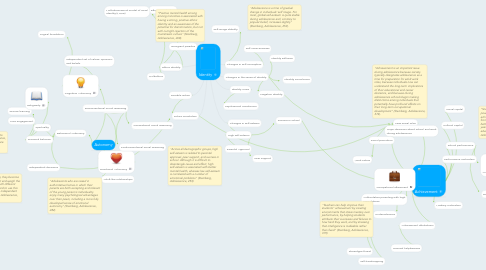Identity
by Kiana Garvey

1. Possible selves
2. Future orientation
3. Ethnic Identity
4. Ethnic socialization
5. Immigrant paradox
6. Multidimensional model of racial identity (MMRI)
7. Multiethnic
8. Autonomy
9. Cognitive Autonomy
10. Logical foundation
11. Behavioral Autonomy
12. Emotional Autonomy
13. Adult-like relationships
14. Independent decisions
15. Independent set of values, opinions, and beliefs
16. Moral reasoning
17. Preconventional moral reasoning
18. Conventional moral reasoning
19. Postconventional moral reasoning
20. Prosocial behavior
21. Service learning
22. Religiosity
23. Spirituality
24. Civic engagement
25. "Across all demographic groups, high self-esteem is related to parental approval, peer support, and success in school. Although it is difficult to disentangle cause and effect, high self-esteem is associated with better mental health, whereas low self-esteem is correlated with a number of emotional problems" (Steinberg, Adolescence, 253).
26. "Positive mental health among among minorities is associated with having a strong, positive ethnic identity and an awareness of the potential for discrimination, but not with outright rejection of the mainstream culture" (Steinberg, Adolescence, 268).
27. "Adolescents who are raised in authoritative homes in which their parents are both accepting and tolerant of the young person's individuality enjoy many psychological advantages over their peers, including a more fully developed sense of emotional autonomy" (Steinberg, Adolescence, 282).
28. "As individuals mature, they become better able to seek out and weigh the advice of individuals with different degrees of expertise and to use this information in making independent decisions" (Steinberg, Adolescence, 289).
29. "Involvement in community leads to gains in social responsibility, tolerance, and the importance individuals place on helping others" (Steinberg, Adolescence, 301).
30. Changes in self-conception
31. Changes in self-esteem
32. Changes in the sense of identity
33. High self-esteem
34. Parental Approval
35. Peer support
36. Success in school
37. Identity Diffusion
38. Identity Foreclosure
39. Negative Identity
40. Self-consciousness
41. Self-image stability
42. Identity Crisis
43. Psychosocial moratorium
44. Achievement
45. New social roles
46. Major decisions about school and work during adolescence
47. Underachievers
48. Self-handicapping
49. Mastery motivation
50. Performance motivation
51. Achievement attributions
52. Learned helplessness
53. Authoritative parenting with high expectations
54. Stereotype threat
55. Cultural capital
56. Social capital
57. School performance
58. Academic achievement
59. Educational attainment
60. Social promotion
61. Work values
62. Occupational attainment
63. "Adolescence is a time of gradual change in individuals' self image. For most, global self-esteem is quite stable during adolescence and, contrary to popular belief, increases slightly" (Steinberg, Adolescence, 253).
64. "Achievement is an important issue during adolescence because society typically designates adolescence as a time for preparation for adult work roles, because individuals now can understand the long-term implications of their educational and career decisions, and because during adolescence schools begin making distinctions among individuals that potentially have profound effects on their long-term occupational development" (Steinberg, Adolescence, 374).
65. "Teachers can help improve their students'' achievement by creating environments that stress mastery over performance, by helping students attribute their successes and failures to how hard they work, and by stressing that intelligence is malleable rather than fixed" (Steinberg, Adolescence, 379).
66. "Socioeconomic status is an extremely powerful influence on educational achievement.. Generally, adolescents from higher social classes perform better in school and complete more years of schooling than do their less advantaged counterparts" (Steinberg, Adolescence, 395).


